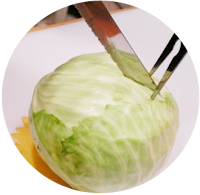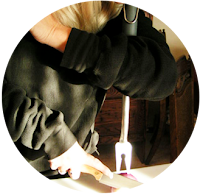When there is a lot of chopping and shredding involved in a recipe, of course a food processor would be the easiest and quickest means of completing the task. Some of us simply do not own a food processor. If you have the means to purchase one, it would definitely be worth its weight in gold to the physically challenged!
 |
| Prepare cabbage or lettuce for shredding by first placing the head on a cutting board (preferably a wooden board) on top of a rubber jar opener to hold the head in place. |
However, I have developed a few ways to help those of you who do not have one. For example: when preparing cabbage or lettuce for shredding (even if you are using a processor, this is the first step for cabbage and lettuce) the first thing you will need to do is place the head on a cutting board (preferably a wooden board) on top of a rubber jar opener to hold the head in place. Using a large, sharp serrated knife, pierce the head with the tip, making a starter cut and always keep the blade facing away from your body. If you are unable to hold the head of cabbage in place with your hand, pierce the head with a large, thick-handled carving fork for stability. For those of you who cannot hold the large fork in your hands, place the top of the fork’s handle in the bend of your arm at the elbow and squeeze as tightly as possible, stabilizing the top of the fork with your chin or cheek. After you have a starter cut, place the blade in the cut horizontally, begin moving the knife through the cabbage horizontally in a back and forth motion just until you have a deep cut. Remove the fork from the cabbage. Place your hand or forearm on the cabbage on the back side (the smooth side) of the knife using the weight of your body to apply pressure move the head of cabbage back and forth until fully cut in half, repeat to cut into quarters. Remember to place the knife into the hand that has the most strength.
No worries if you have problems at first. I promise, it soon just becomes a way of life and it gets so much easier, so please do not give up!
Place each quarter flat on the board and using the same knife right above the visible core position the knife at an angle, place the palm of your hand or forearm on the smooth back side of the knife, use the weight of your body to apply pressure, and remove the core. Once the core has been removed, continue using one of the holding methods (hand or fork) to hold quarters in place to cut one “wide slice against the grain.” For smaller pieces, place the tip of the knife onto the board over top of a small pile of cabbage or lettuce, using one hand on the handle and the other hand or forearm on the backside of the blade. Use the weight of your body to maneuver the knife. The first movement is to push the knife forward away from you as you apply pressure, then when pulling knife back toward you, slightly lift up on the handle. The tip should never leave the board, only the back of the blade closest to the handle.Continue this procedure until you have reached your desired size.
You will also use this same knife procedure to chop nuts, onions, carrots, peppers, celery, etc. When you are dicing or slicing celery, carrots, peppers, onions, cucumbers, or squash and are unable to hold the object in place with your hand, you can hold it in place with a dinner fork or carving fork. First, pierce the object you are dicing with the fork; then with the other hand, push the chef’s knife through by pushing forward and lifting the handle only and pull back. The tip never leaves the board. You may also use your forearm to hold the item in place.
The second option: if you are unable to bend your fingers but can use your hand to hold in place, lay your hand flat on the object, keeping the thumb tucked closely to the hand, and follow the same knife procedure. The key is not to be in a hurry. Take your time and learn the steps. Before you know it, it will become second nature.
Obviously, one cannot use a fork to pierce a nut. The third option is to use a mini food processor to chop nuts, garlic, parsley—all smaller items. Mini food processors are very inexpensive, easy to use, easy to clean, but most importantly, manageable for those of us who cannot lift heavy things and have problems holding little things in our hands. Place the nut in the processor and pulse until the desired size is reached.
GARLIC: The absolute best solution for people who have problems mincing small garlic cloves is buy it already minced in a jar. There is also garlic paste on the market that is wonderful and easy to use. Most of the recipes in this book call for jarred garlic. Of course, if you are able to mince garlic, by all means go fresh. I have found over the years that I cannot tell the difference between jarred, paste, and fresh. Today there are so many alternatives out there to make life in the kitchen quick and easy. Most are great products, but in some recipes there is just no substitute for fresh.

No comments:
Post a Comment